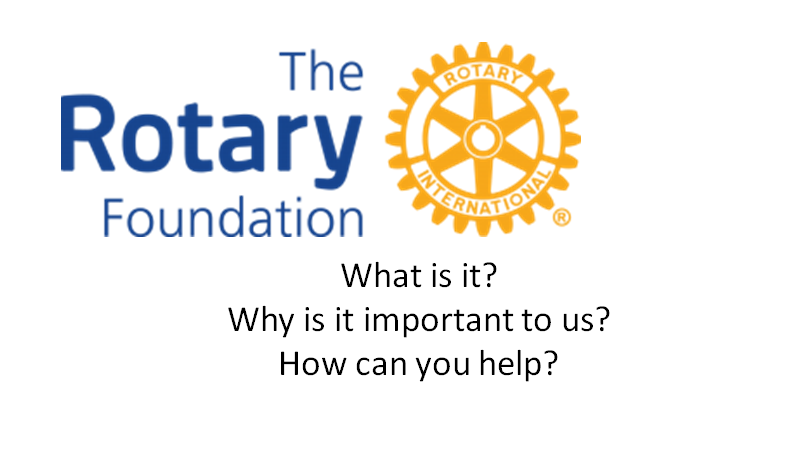
Ana introduced John Farrow, who actually needs no introduction, as our speaker. John did say that he joined the club in 1990.
The Rotary Foundation:
John talked about what it is, why it is important, and how you can help.
The Foundation was created in 1917 following the Atlanta Rotary Convention, with an initial amount of $26.50. (Scribe’s note – The Bank of Canada says the value in 2020 would be $473.16). Every year, 50% of your Annual Fund donation goes back to the Districts (District Dedicated Funds, or DDF), and 50% goes to the World Fund to advance the goals of Rotary. The Global Fund matches District Designated Funds and makes the scope of projects larger. There is never enough money to match all the applications that are received. The Foundation encourages - and requires -partnerships among Rotary Clubs. These will be even more important as starting July 1st R.I. will no longer match club and donor monies for a project. John notes this is a challenge, but with the partnerships our club has made thanks to people like Bill Gray and John Gale (and others) we can overcome this. The ending of R.I. matching dollars is actually a testament to the quality of the projects out there.
The grants in order of the amounts awarded go to the following areas of focus. 1. Preventing Disease, 2. Clean Water, 3. Education, 4. Growing Local Economies, 5. Saving Mothers and Children, and 6. Promoting Peace.
Charity Navigator gives The Rotary Foundation the highest rating possible, as 92% of the money goes to projects.

Why is it important to us? It aligns with our reasons for joining Rotary. Our club has benefited by thousands of dollars over the years. There are always six or seven active projects involving our club, representing hundreds of thousands of dollars.
Many of our members donate to The Foundation. It puts the “international” in Rotary International as Bill Gray reminded John recently. The Annual Fund invests money for three years before investing in a project, and the interest accrued helps pay many of the expenses of running the Foundation.
"Rules are a good thing", according to John. There are very rigorous rules to adhere to in order to receive a grant. A project must be sustainable. A Rotary Club partner is required at the other end. It’s important for a club to have champions, and we have this in Bill Gray and John Gale. We also have dedicated people in District 7040. Bonnie Black and Bette Miller lead the effort in our District, and John remarked after attending the Global Grants Workshop, he was even more confident in donating to the Foundation.
John then used our Rotary FAR project to illustrate the way that money can be combined. Our club contributed $15,000, and with money we raised outside of our club funds it became $21,200, but the Rotary Clubs of Kingston, Napanee and the Passport Club all contributed. Five clubs in India contributed, as well as District Designated Funds, and The World Fund. So…all combined to support a project that has a value of almost $109,000. Through working together with other clubs, and with The Foundation, we can do things that we couldn’t do on our own.

How can you donate?
The Annual Fund is the primary source of money for project grants. We have a goal of “Every Rotarian Every Year”. Every year, 50% goes to the World Fund and 50% to the District Designated Fund.
You can donate by writing a cheque, by a monthly withdrawal plan, or monthly on your credit card. You can choose a specific area of focus where your money will go. You can also support Polio Plus, and you can also support a specific project that you know of until it is fully funded.
The Endowment Fund ensures long term viability of Rotary International programs. Money is invested and only the interest is used.
A Benefactor is someone how has added The Foundation as a beneficiary of their will.
John outlined the various qualifications, you can achieve, starting with being a member of the Paul Harris Society ($1000). Increased donations take you to Major Donor, Bequest Society, and Arch Klumph Society. Our club aims to have every member donate every year. There is also a Rotary credit card in which a small amount from every purchase goes to The Foundation. It’s a small amount but has raised over $8.6 million in recent years.
Our club has constantly been at our near the top of giving, with the average per member of $360 - first in the District to date. Over all donations have been $65,750, with $7,214 to Polio Plus, again, first in the District.
You may contact John for any information you need about making a donation to any of the funds.
Questions:
Thinking about directing donations, is the Rotary FAR project now fully funded? Yes but there are always new projects being proposed.
Bill Gray noted that most clubs don’t have enough money to do large projects, and so they find allies. We have a very active International Committee. Cooperation between clubs is increasing and we are finding new partnerships. We have built a network of partner clubs around the world, and it has benefited our FAR project.
Ana offered our thanks to John for his presentation.
Paul Harris Society recognition:
Ana announced that Heather Nogrady is not only a Paul Harris Society member but has achieved recognition for being a Paul Harris + 2.
Speaker thanks was offered by Bill Egnatoff who also noted the many ways that John has contributed to our club and to Rotary. He pointed out an interesting slip that John made that actually formed a new word, “transparity”, which seems to describe balancing the inequities in the world.


